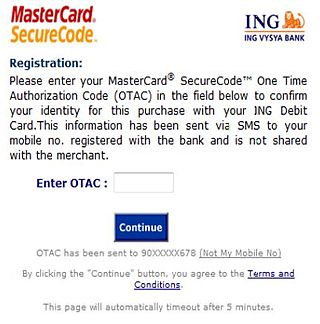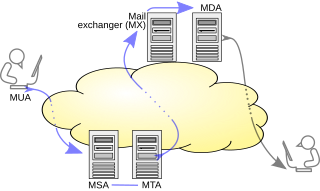
Email hacking is the unauthorized access to, or manipulation of, an account or email correspondence. [1] [2]

Email hacking is the unauthorized access to, or manipulation of, an account or email correspondence. [1] [2]
Email is a very widely used communication method. If an email account is hacked, it can allow the attacker access to the personal, sensitive or confidential information in the mail storage; as well as allowing them to read new incoming and outgoing email - and to send and receive as the legitimate owner. On some email platforms, it may also allow them to set up automated email processing rules. All of these could be very harmful for the legitimate user.
There are a number of ways in which a hacker can illegally gain access to an email account.
A virus or other malware can be sent via email, and if executed may be able to capture the user's password and send it to an attacker. [3]
Phishing involves emails that appear to be from legitimate sender but are scams which ask for verification of personal information, such as an account number, a password, or a date of birth. If unsuspecting victims respond, the result may be stolen accounts, financial loss, or identity theft. [3]
Email on the internet is sent by the Simple Mail Transfer Protocol (SMTP). While mail can be encrypted between mail servers, this is not typically enforced, but instead Opportunistic TLS is used - where mail servers negotiate for each email connection whether it will be encrypted, and to what standard. Where a mail flow between servers is not encrypted, it could be intercepted by an ISP or government agency and the contents can be read by passive monitoring. [4] For higher security, email administrators can configure servers to require encryption to specified servers or domains.
Email spoofing and similar issues which facilitate phishing [5] are addressed by the 'stack' of Sender Policy Framework (SPF), DomainKeys Identified Mail (DKIM) and Domain-based Message Authentication, Reporting and Conformance (DMARC). Setting all these in place is technically challenging, and not visible to the end user, so implementation progress has been slow. A further layer, Authenticated Received Chain (ARC), allows mail flow through intermediate mail servers such as mailing lists or forwarding services to be better handled - a common objection to implementation.
Businesses typically have advanced firewalls, anti-virus software and intrusion detection systems (IDS) to prevent or detect improper network access. They may also have security specialists perform an audit on the company and hire a Certified Ethical Hacker to perform a simulated attack or "pen test" in order to find any gaps in security. [6]
Although companies may secure its internal networks, vulnerabilities can also occur through home networking. [6] Email may be protected by methods, such as, creating a strong password, encrypting its contents, [7] or using a digital signature.
If passwords are leaked or otherwise become known to an attacker, having two-factor authentication enabled may prevent improper access.
Notable cases of email hacks include:

Electronic mail is a method of transmitting and receiving messages using electronic devices. It was conceived in the late–20th century as the digital version of, or counterpart to, mail. Email is a ubiquitous and very widely used communication medium; in current use, an email address is often treated as a basic and necessary part of many processes in business, commerce, government, education, entertainment, and other spheres of daily life in most countries.

A password, sometimes called a passcode, is secret data, typically a string of characters, usually used to confirm a user's identity. Traditionally, passwords were expected to be memorized, but the large number of password-protected services that a typical individual accesses can make memorization of unique passwords for each service impractical. Using the terminology of the NIST Digital Identity Guidelines, the secret is held by a party called the claimant while the party verifying the identity of the claimant is called the verifier. When the claimant successfully demonstrates knowledge of the password to the verifier through an established authentication protocol, the verifier is able to infer the claimant's identity.
The Simple Mail Transfer Protocol (SMTP) is an Internet standard communication protocol for electronic mail transmission. Mail servers and other message transfer agents use SMTP to send and receive mail messages. User-level email clients typically use SMTP only for sending messages to a mail server for relaying, and typically submit outgoing email to the mail server on port 587 or 465 per RFC 8314. For retrieving messages, IMAP is standard, but proprietary servers also often implement proprietary protocols, e.g., Exchange ActiveSync.

An email client, email reader or, more formally, message user agent (MUA) or mail user agent is a computer program used to access and manage a user's email.
Various anti-spam techniques are used to prevent email spam.
Hushmail is an encrypted proprietary web-based email service offering PGP-encrypted e-mail and vanity domain service. Hushmail uses OpenPGP standards. If public encryption keys are available to both recipient and sender, Hushmail can convey authenticated, encrypted messages in both directions. For recipients for whom no public key is available, Hushmail will allow a message to be encrypted by a password and stored for pickup by the recipient, or the message can be sent in cleartext. In July 2016, the company launched an iOS app that offers end-to-end encryption and full integration with the webmail settings. The company is located in Vancouver, British Columbia, Canada.

Phishing is a form of social engineering and scam where attackers deceive people into revealing sensitive information or installing malware such as ransomware. Phishing attacks have become increasingly sophisticated and often transparently mirror the site being targeted, allowing the attacker to observe everything while the victim is navigating the site, and transverse any additional security boundaries with the victim. As of 2020, it is the most common type of cybercrime, with the FBI's Internet Crime Complaint Center reporting more incidents of phishing than any other type of computer crime.
Internet security is a branch of computer security. It encompasses the Internet, browser security, web site security, and network security as it applies to other applications or operating systems as a whole. Its objective is to establish rules and measures to use against attacks over the Internet. The Internet is an inherently insecure channel for information exchange, with high risk of intrusion or fraud, such as phishing, online viruses, trojans, ransomware and worms.

A one-time password (OTP), also known as a one-time PIN, one-time authorization code (OTAC) or dynamic password, is a password that is valid for only one login session or transaction, on a computer system or other digital device. OTPs avoid several shortcomings that are associated with traditional (static) password-based authentication; a number of implementations also incorporate two-factor authentication by ensuring that the one-time password requires access to something a person has as well as something a person knows.
Email authentication, or validation, is a collection of techniques aimed at providing verifiable information about the origin of email messages by validating the domain ownership of any message transfer agents (MTA) who participated in transferring and possibly modifying a message.

A message submission agent (MSA), or mail submission agent, is a computer program or software agent that receives electronic mail messages from a mail user agent (MUA) and cooperates with a mail transfer agent (MTA) for delivery of the mail. It uses ESMTP, a variant of the Simple Mail Transfer Protocol (SMTP), as specified in RFC 6409.
In cryptography, CRAM-MD5 is a challenge–response authentication mechanism (CRAM) based on the HMAC-MD5 algorithm. As one of the mechanisms supported by the Simple Authentication and Security Layer (SASL), it is often used in email software as part of SMTP Authentication and for the authentication of POP and IMAP users, as well as in applications implementing LDAP, XMPP, BEEP, and other protocols.
Email spoofing is the creation of email messages with a forged sender address. The term applies to email purporting to be from an address which is not actually the sender's; mail sent in reply to that address may bounce or be delivered to an unrelated party whose identity has been faked. Disposable email address or "masked" email is a different topic, providing a masked email address that is not the user's normal address, which is not disclosed, but forwards mail sent to it to the user's real address.
Opportunistic TLS refers to extensions in plain text communication protocols, which offer a way to upgrade a plain text connection to an encrypted connection instead of using a separate port for encrypted communication. Several protocols use a command named "STARTTLS" for this purpose. It is a form of opportunistic encryption and is primarily intended as a countermeasure to passive monitoring.
Email encryption is encryption of email messages to protect the content from being read by entities other than the intended recipients. Email encryption may also include authentication.
MailChannels is a Canadian technology company that is specialized in email security for businesses and internet service providers (ISPs). Founded in 2004 by Ken Simpson and headquartered in Vancouver, British Columbia, the company operates in the areas of email security and infrastructure market. The business provides a variety of products and services designed to safeguard email systems against spam, phishing, and other harmful content. Simultaneously, they guarantee the dependable delivery of legitimate messages. Additionally, they offer a mail relay API for numerous websites.
SMTP Authentication, often abbreviated SMTP AUTH, is an extension of the Simple Mail Transfer Protocol (SMTP) whereby a client may log in using any authentication mechanism supported by the server. It is mainly used by submission servers, where authentication is mandatory.
With the invention of online message-transfer methods like email, an array of anti-spam techniques has been developed in regard to email spam. Email spam refers to the unwarranted inundation of unsolicited bulk emails. These are methods created on the client arrangement of a situation, rather than the server-side.

Proton Mail is a Swiss end-to-end encrypted email service founded in 2013 headquartered in Plan-les-Ouates, Switzerland. It uses client-side encryption to protect email content and user data before they are sent to Proton Mail servers, unlike other common email providers such as Gmail and Outlook.com. The service can be accessed through a webmail client, the Tor network, Windows, macOS and Linux (beta) desktop apps and iOS and Android apps.
Criticism of Dropbox, an American company specializing in cloud storage and file synchronization and their flagship service of the same name, centers around various forms of security and privacy controversies. Issues include a June 2011 authentication problem that let accounts be accessed for several hours without passwords; a July 2011 privacy policy update with language suggesting Dropbox had ownership of users' data; concerns about Dropbox employee access to users' information; July 2012 email spam with reoccurrence in February 2013; leaked government documents in June 2013 with information that Dropbox was being considered for inclusion in the National Security Agency's PRISM surveillance program; a July 2014 comment from NSA whistleblower Edward Snowden criticizing Dropbox's encryption; the leak of 68 million account passwords on the Internet in August 2016; and a January 2017 accidental data restoration incident where years-old supposedly deleted files reappeared in users' accounts.